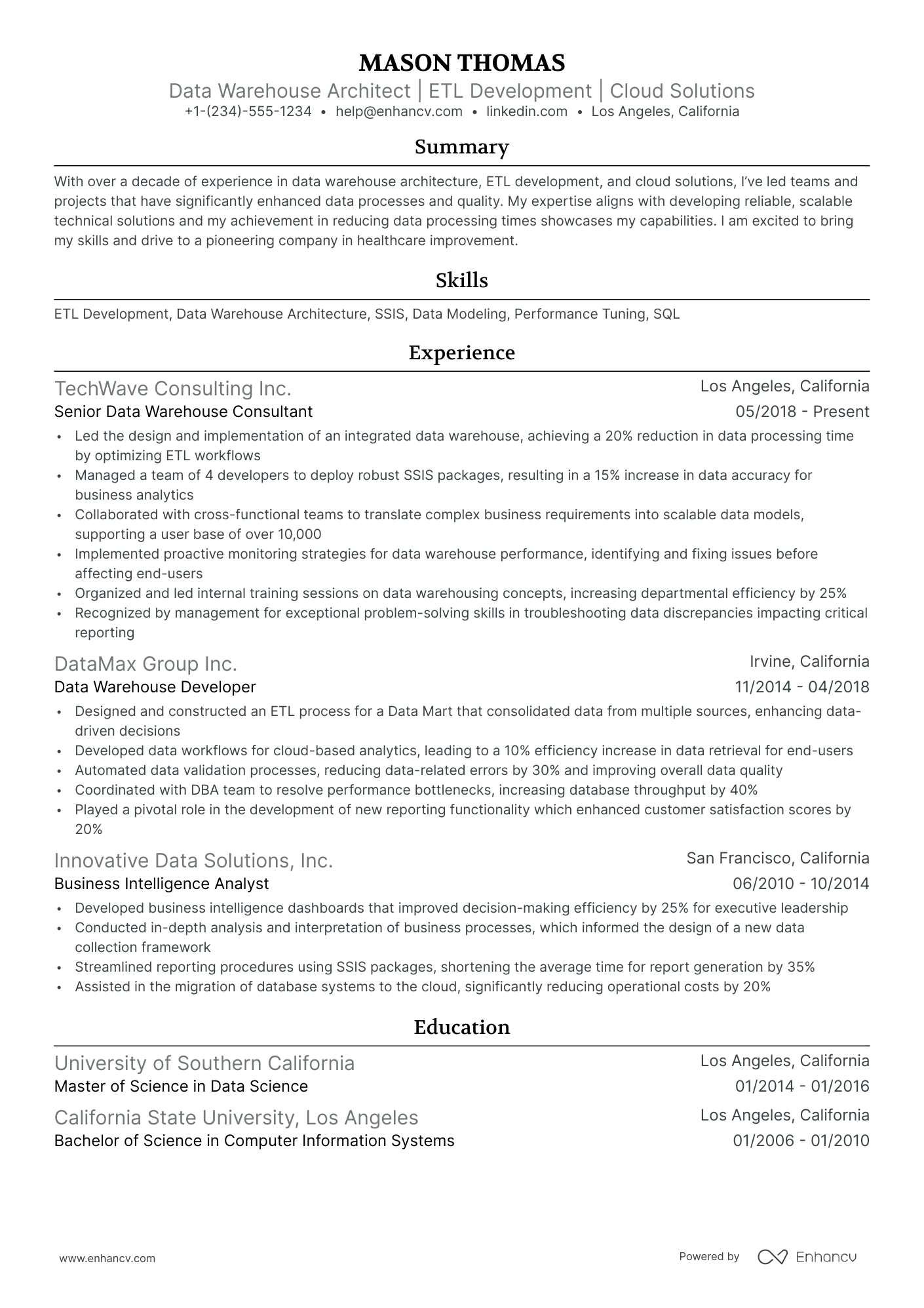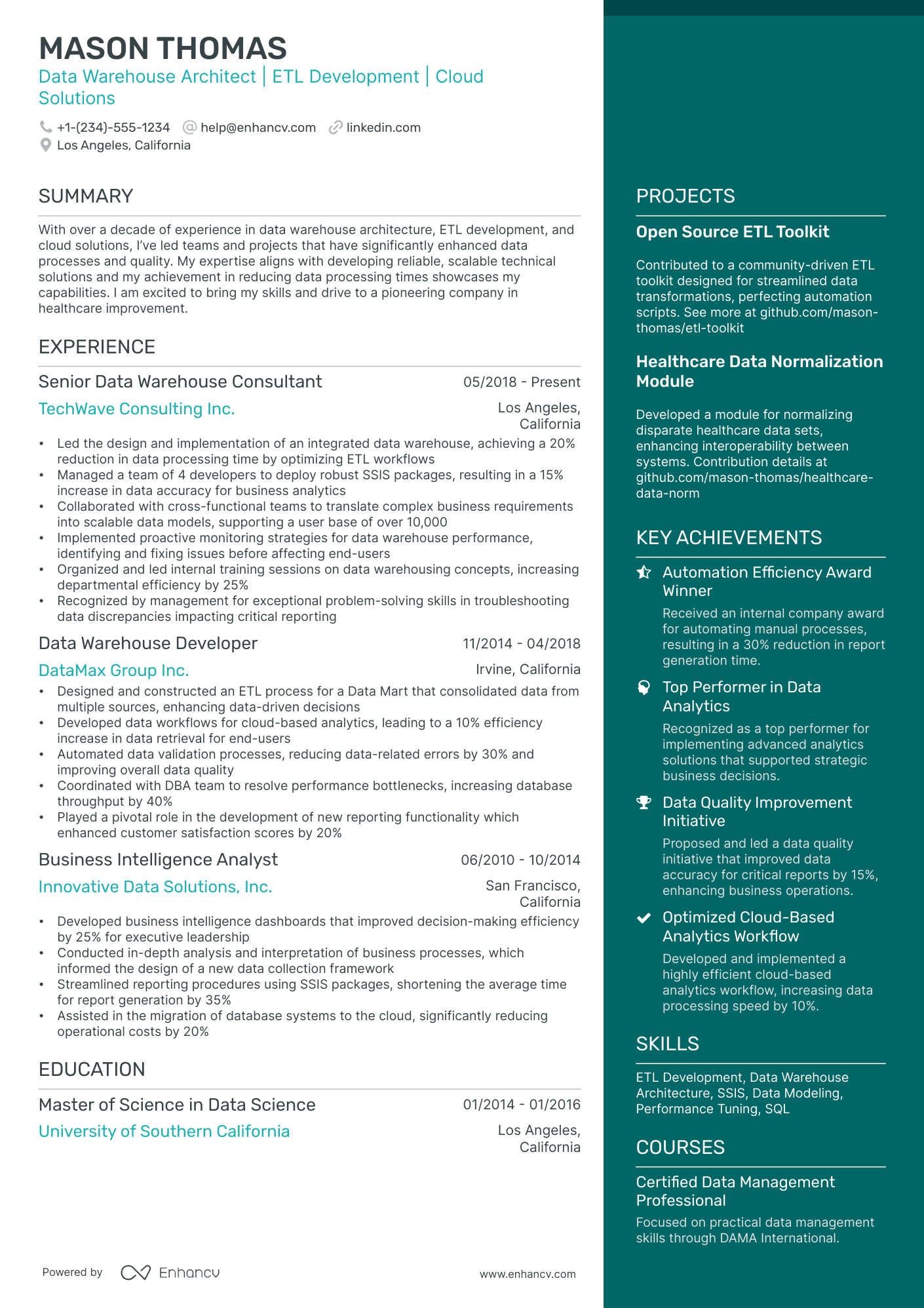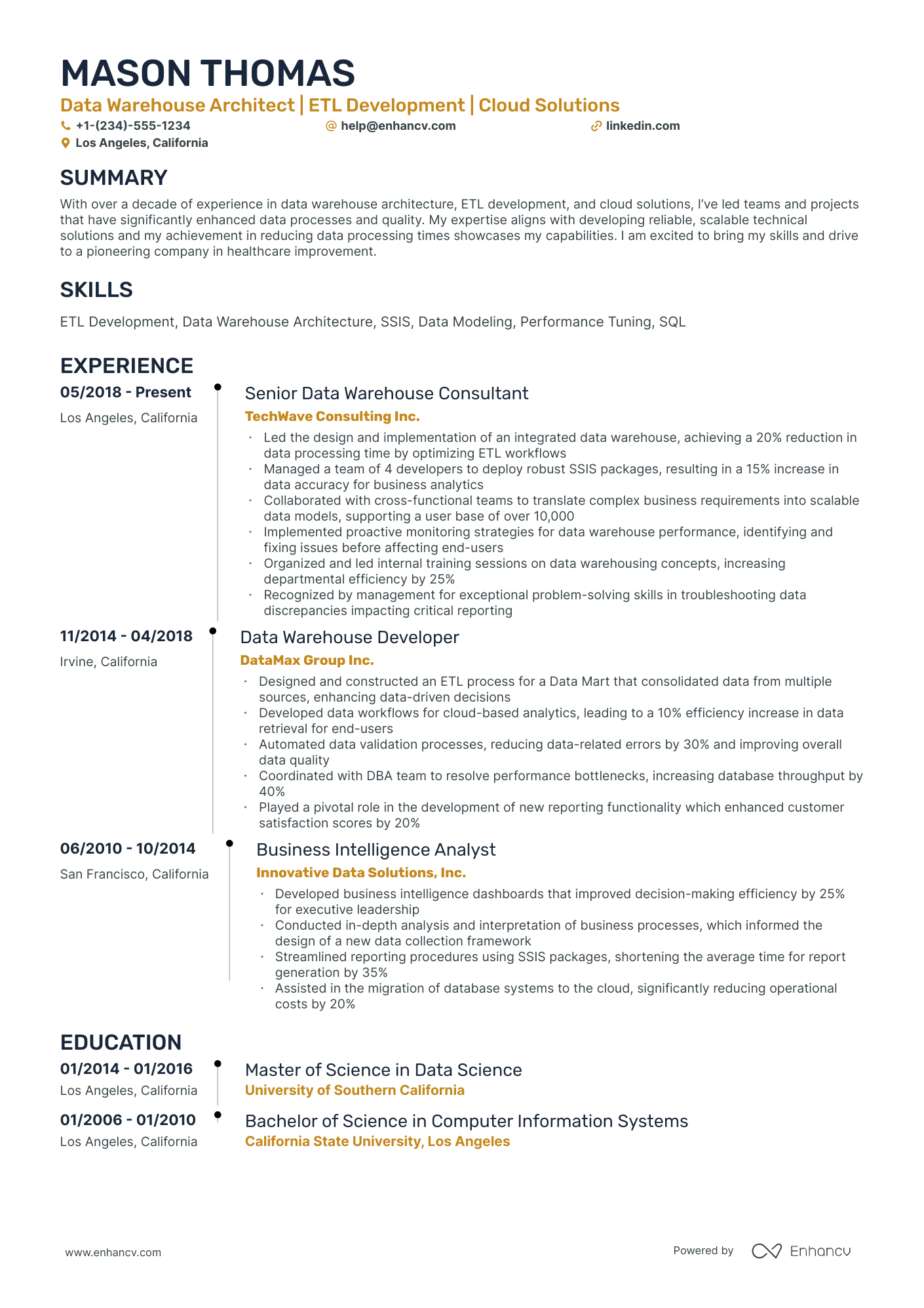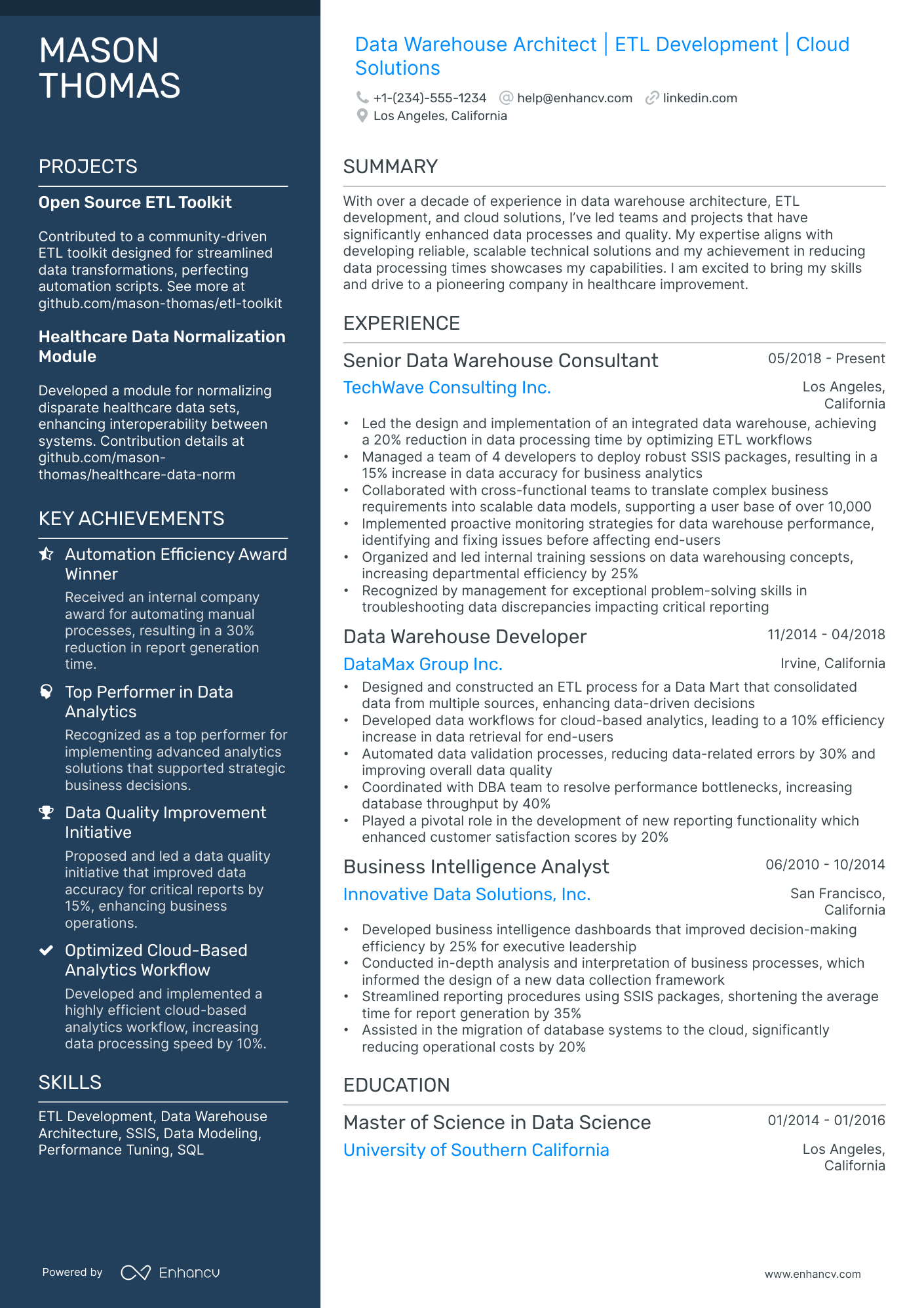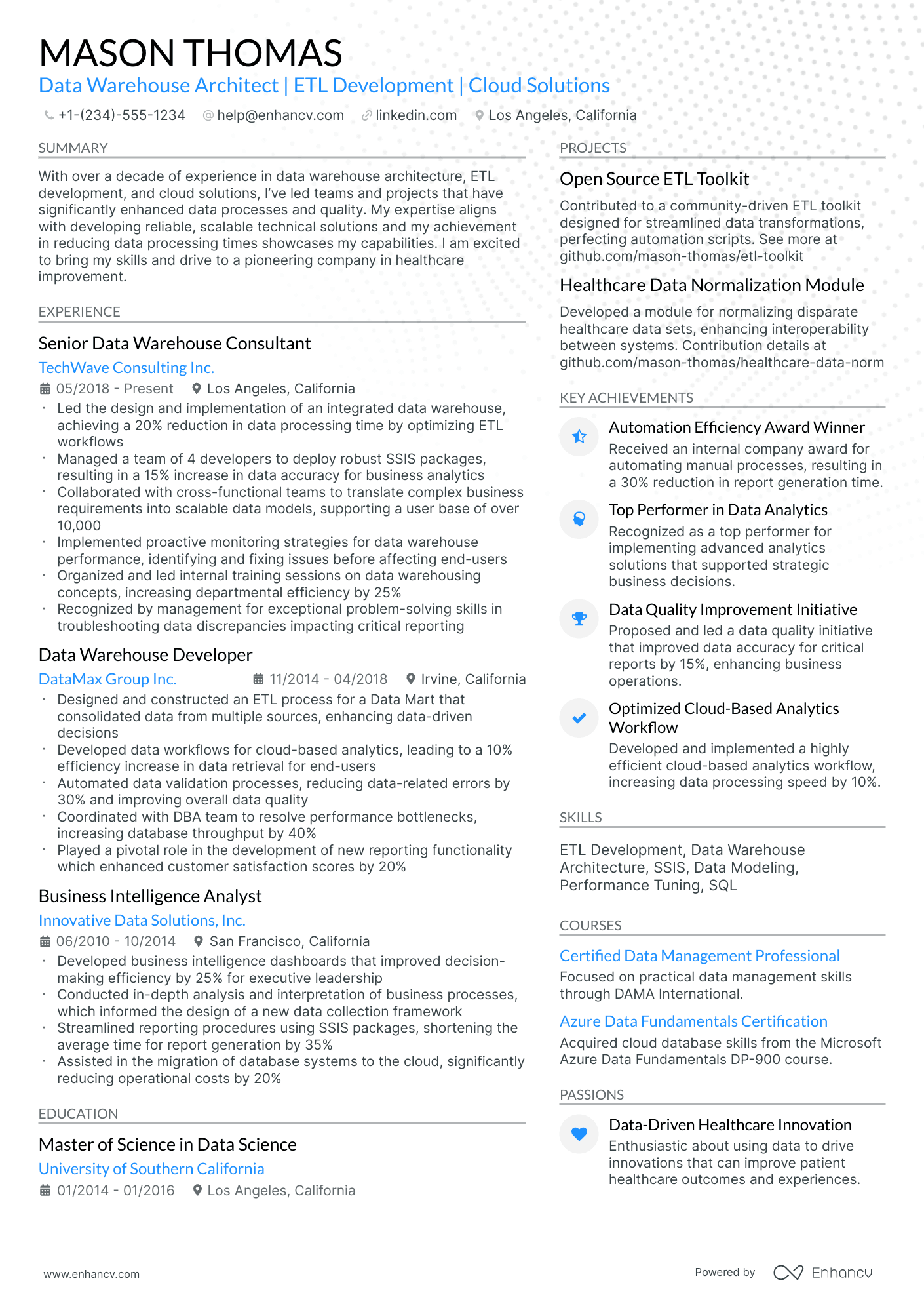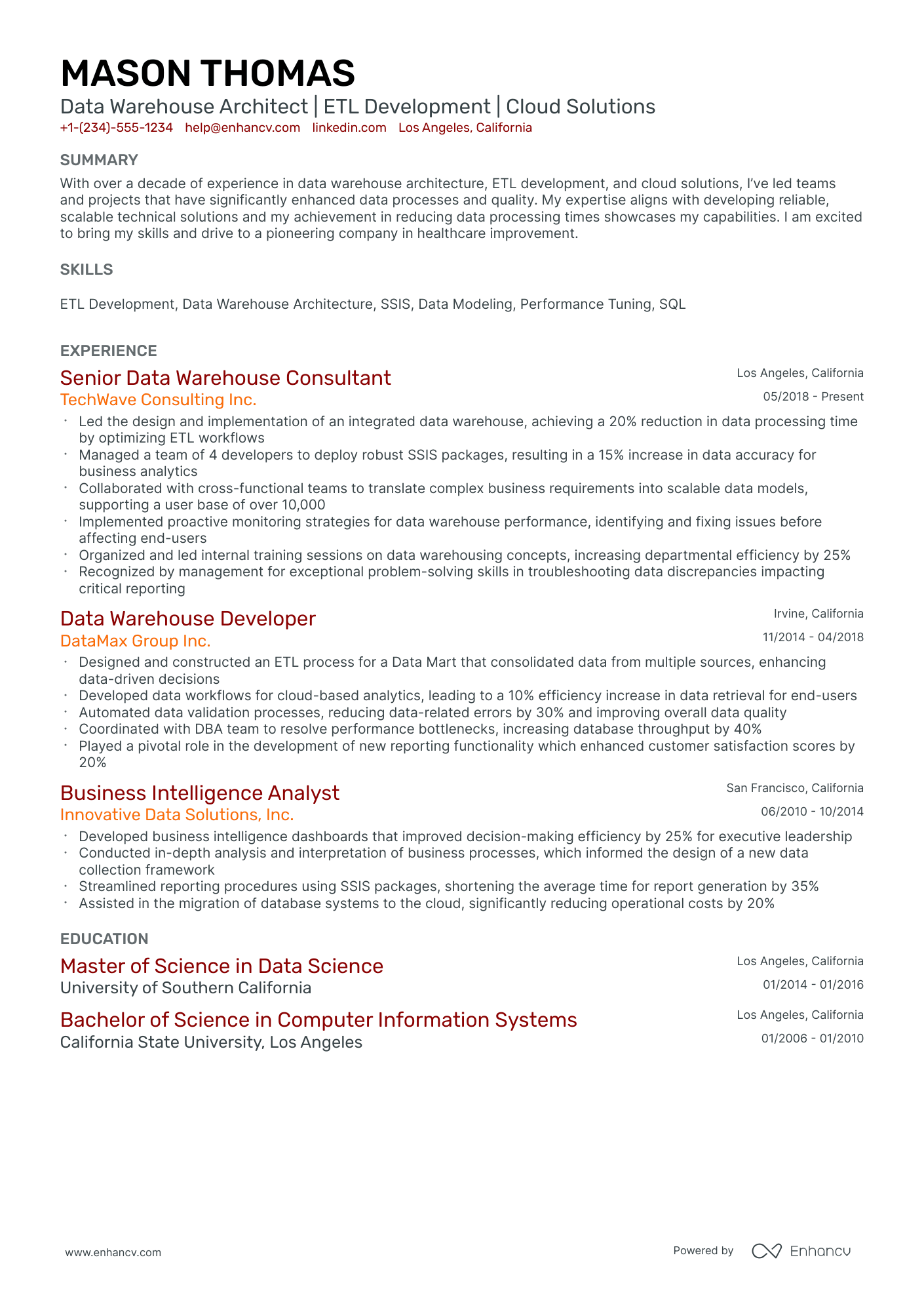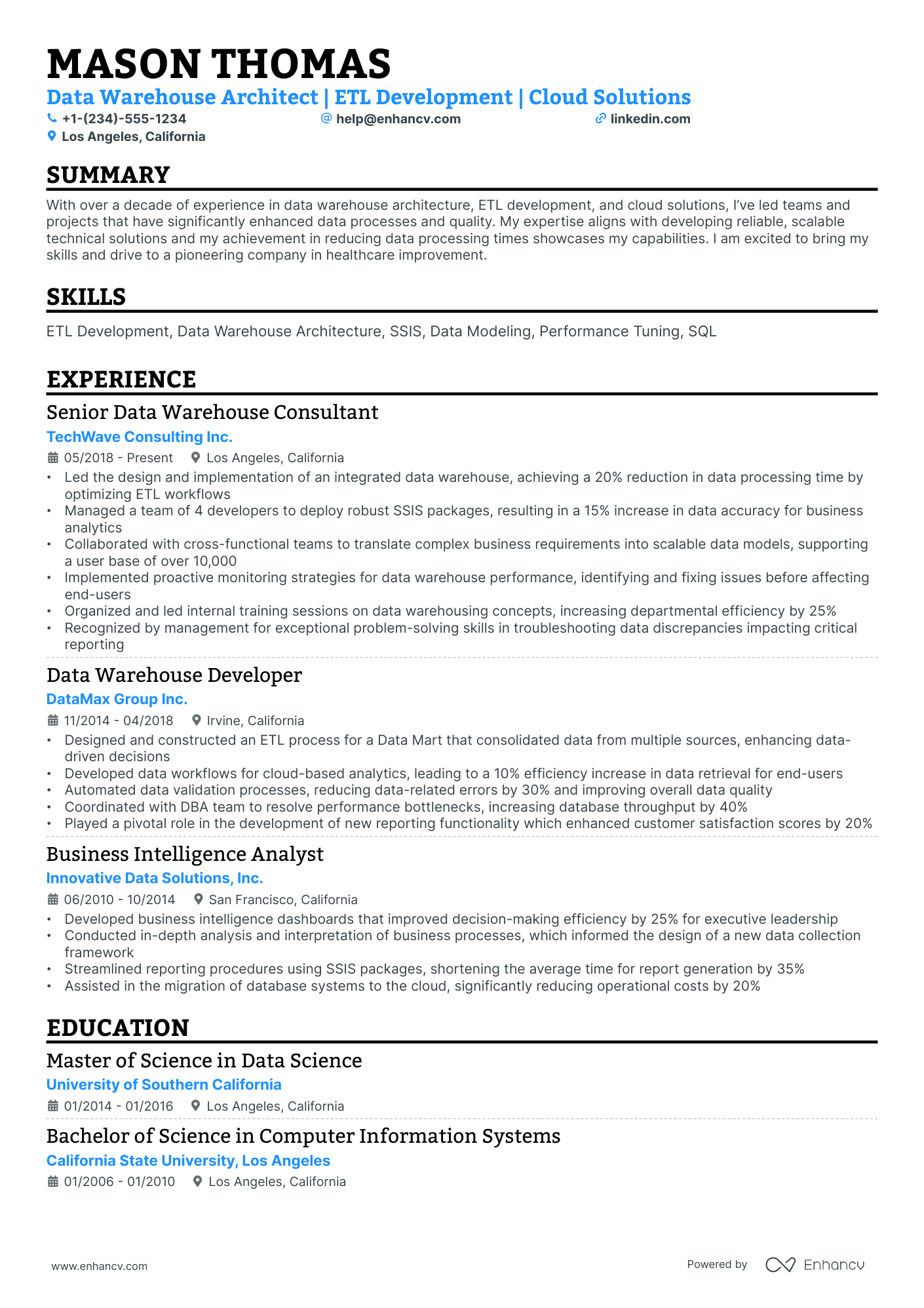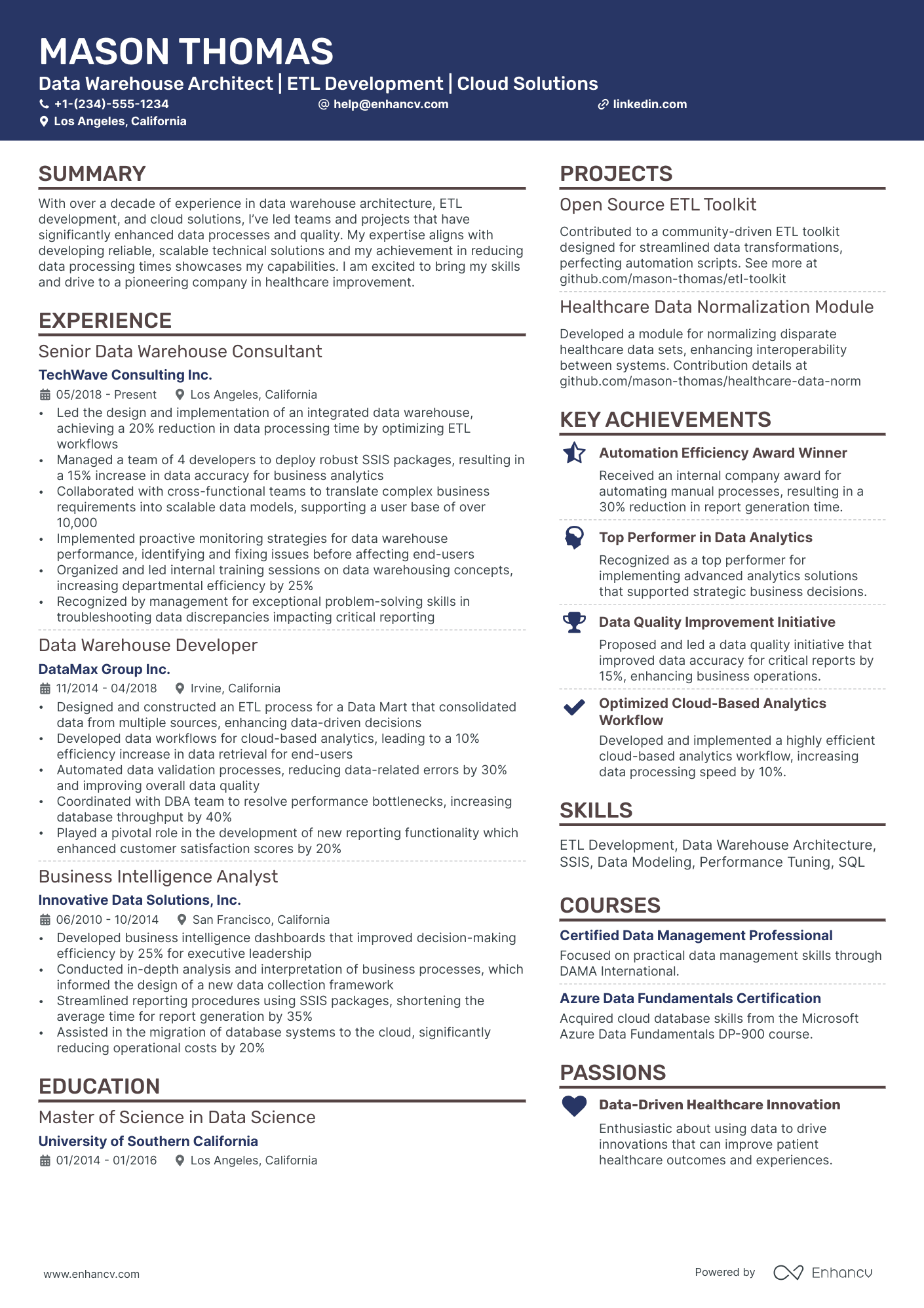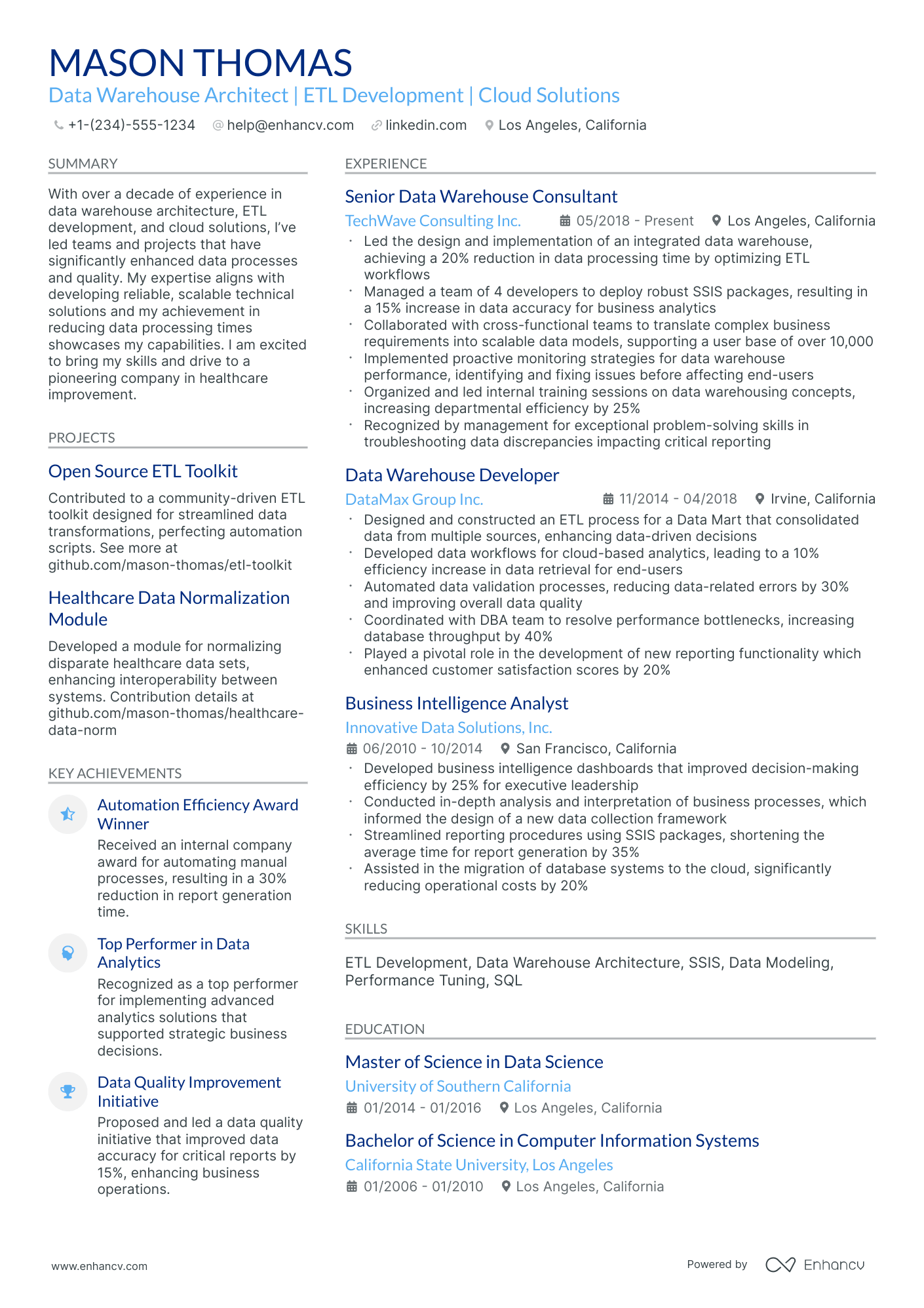As a data warehouse architect, articulating the complex nature of the systems you have designed and optimized on your resume can be a daunting challenge. Fortunately, our guide provides concise strategies and industry-specific language that will help you distill and present your technical experiences understandable and impressive to potential employers.
- Format your data warehouse architect resume to ensure that it balances professionalism with creativity, and follows the best practices.
- Match the data warehouse architect job requirements by including industry keywords on your resume.
- Use various resume sections to showcase your skills and achievements to answer why you're the best candidate for the data warehouse architect role.
Take inspiration from leading data warehouse architect resume examples to learn how to tailor your experience.
- Data Center Technician Resume Example
- Enterprise Data Architect Resume Example
- Data Entry Analyst Resume Example
- Database Architect Resume Example
- Data Architect Resume Example
- Data Center Engineer Resume Example
- Python Data Scientist Resume Example
- Excel Data Analyst Resume Example
- Data Warehouse Engineer Resume Example
- Data Reporting Analyst Resume Example
How to style your data warehouse architect resume: layout and format
When creating your data warehouse architect resume, have you ever wondered how long it should be? Experts point out that it should be between one and two pages. Choose the longer format, if you happen to have over a decade of relevant experience. What is more, resume formats play a crucial role in presenting your experience. Use the:- Reverse-chronological resume format to highlight your experience;
- Functional skill-based resume format if you have less experience and want to focus on skills;
- Hybrid resume format to guide recruiters through both your experience and skills.
- Make sure your headline is simple and includes the job you're applying for or your current role, an abbreviation of a certificate you have, or even your professional area of interest;
- Always tailor your data warehouse architect resume to the role you're applying for by matching job requirements to your experience via different resume sections;
- Once you've created your resume, download it in PDF (unless otherwise specified). This is to ensure readability and that the layout remains fixed.
Different markets have specific resume formats – a Canadian resume could vary in layout.
Upload & Check Your Resume
Drop your resume here or choose a file. PDF & DOCX only. Max 2MB file size.
PRO TIP
If you're in the process of obtaining your certificate or degree, list the expected date you're supposed to graduate or be certified.
Traditional sections, appreciated by recruiters, for your data warehouse architect resume:
- Clear and concise header with relevant links and contact details
- Summary or objective with precise snapshot of our career highlights and why you're a suitable candidate for the data warehouse architect role
- Experience that goes into the nuts and bolts of your professional qualifications and success
- Skills section(-s) for more in-depth talent-alignment between job keywords and your own profile
- Education and certifications sections to further show your commitment for growth in the specific niche
What recruiters want to see on your resume:
- Experience in designing and implementing scalable data warehouse solutions, including knowledge of data modeling, ETL processes, and data warehousing methodologies such as Kimball or Inmon.
- Proficiency in SQL and experience with data warehouse technologies such as Amazon Redshift, Snowflake, Google BigQuery, Microsoft Azure SQL Data Warehouse, or Oracle Exadata.
- Understanding of business intelligence (BI) tools and reporting software like Tableau, Power BI, or Looker, and the ability to integrate these with the data warehouse.
- Knowledge of data governance, data quality management, and compliance standards relevant to data warehousing, such as GDPR, HIPAA, or CCPA.
- Demonstrated experience with cloud services and architecture, particularly in the context of data warehousing and analytical environments within AWS, Azure, or GCP ecosystems.
Adding your relevant experience to your data warehouse architect resume
If you're looking for a way to show recruiters that your expertise is credible, look no further than the resume experience section.
Your data warehouse architect resume experience can be best curated in a structured, bulleted list detailing the particulars of your career:
- Always integrate metrics of success - what did you actually achieve in the role?
- Scan the data warehouse architect advert for your dream role in search of keywords in the job requirements - feature those all through your past/current experience;
- Dedicate a bullet (or two) to spotlight your technical capabilities and how you're able to use the particular software/technology in your day-to-day roles;
- Write simple by including your responsibility, a job advert keyword or skill, and a tangible outcome of your success;
- Use the experience section to also define the unique value of working with you in the form of soft skills, relevant feedback, and the company culture you best thrive in.
Industry leaders always ensure that their resume experience section offers an enticing glimpse at their expertise, while telling a career narrative. Explore these sample data warehouse architect resumes on how to best create your resume experience section.
- Designed and implemented a scalable data warehouse solution for a global e-commerce platform, optimizing data retrieval by 30%.
- Led the migration of 20+ terabytes of data to Amazon Redshift, significantly enhancing report generation efficiency for business units.
- Collaborated with cross-functional teams to understand data needs, formulated ETL processes that resulted in a 25% reduction in load times.
- Initiated a data governance framework that improved data accuracy and integrity for financial reporting in a major banking institution.
- Spearheaded a project that integrated disparate data sources into a cohesive data warehouse, boosting data-driven decision-making.
- Implemented robust data security protocols that complied with regulatory standards, ensuring the protection of sensitive information.
- Developed a data warehouse architecture that supported a dynamic retail analytics platform, leading to a 20% increase in sales.
- Automated ETL workflows, slashing manual processing time by 40% while maintaining data quality standards.
- Designed a business intelligence (BI) tool integration strategy that provided executive leadership with real-time KPI dashboards.
- Conducted a complete overhaul of an outdated data warehouse, implementing a modern infrastructure that halved the company's data processing times.
- Mentored a team of junior data engineers and analysts, fostering a culture of continuous learning and professional growth.
- Orchestrated an inter-departmental collaboration effort to align data warehouse strategy with organizational objectives.
- Managed a portfolio of data warehouse projects for healthcare clients, ensuring compliance with HIPAA and other industry standards.
- Developed a custom data mart solution that enhanced patient data analysis capabilities for healthcare providers.
- Optimized data flow and storage resulting in a 50% improvement in query performance, enhancing patient care and service delivery.
- Kick-started a startup's data warehousing efforts, bridging the gap between raw data collection and actionable insights.
- Engineered automated data pipelines that enabled real-time analytics, creating a competitive edge for the young tech company.
- Deployed a cloud-based data warehouse, achieving cost-effective scalability while catering to the startup's rapid growth.
- Implemented a multi-tenant data warehouse for a Software as a Service (SaaS) provider, improving client data isolation and security.
- Optimized cross-functional reporting capabilities by introducing a custom OLAP cube, aiding in complex data analyses.
- Facilitated seamless data integration from multiple SaaS platforms, enabling unified reporting and insight generation for clients.
- Architected a robust data warehousing environment for a multinational media company that allowed for efficient data storage and analysis of billions of records.
- Pioneered the adoption of new data warehousing technologies, such as columnar storage and data lakes, providing enhanced analytical capabilities.
- Streamlined data processing workflows, enabling data analysts and scientists to deliver insights up to 70% faster.
The following content includes information from "O*NET OnLine" by the U.S. Department of Labor, Employment and Training Administration (USDOL/ETA). Used under the CC BY 4.0 license. The data represents the top responsibilities present on the task lists for data warehouse architect professionals.
Top Responsibilities for Data Warehouse Architect:
- Develop and document database architectures.
- Collaborate with system architects, software architects, design analysts, and others to understand business or industry requirements.
- Develop database architectural strategies at the modeling, design and implementation stages to address business or industry requirements.
- Design databases to support business applications, ensuring system scalability, security, performance, and reliability.
- Develop data models for applications, metadata tables, views or related database structures.
- Design database applications, such as interfaces, data transfer mechanisms, global temporary tables, data partitions, and function-based indexes to enable efficient access of the generic database structure.
- Develop methods for integrating different products so they work properly together, such as customizing commercial databases to fit specific needs.
- Create and enforce database development standards.
- Document and communicate database schemas, using accepted notations.
- Develop data model describing data elements and their use, following procedures and using pen, template or computer software.
Quantifying impact on your resume
- Include the amount of data managed, showcasing the scale and complexity of warehousing projects you've handled.
- Mention the number of data sources integrated, demonstrating your ability to synthesize diverse data streams.
- List the query performance improvements achieved, expressing your effectiveness in optimizing data retrieval.
- State the storage cost reductions attained, proving your skill in cost-efficient data warehousing solutions.
- Quantify the number of reporting dashboards created, reflecting your ability to deliver actionable insights for business users.
- Showcase the data warehouse uptime percentages, proving your efforts in maintaining high availability and reliability.
- Mention the volume of data migrations performed, highlighting your expertise in executing large-scale data transfers.
- Discuss the increase in user adoption rates after warehouse enhancements, showing your work's direct business impact.
Action verbs for your data warehouse architect resume
No experience, no problem: writing your data warehouse architect resume
You're quite set on the data warehouse architect role of your dreams and think your application may add further value to your potential employers. Yet, you have no work experience . Here's how you can curate your resume to substitute your lack of experience:
- Don't list every single role you've had so far, but focus on ones that would align with the job you're applying for
- Include any valid experience in the field - whether it's at research or intern level
- Highlight the soft skills you'd bring about - those personality traits that have an added value to your application
- Focus on your education and certifications, if they make sense for the role.
Recommended reads:
PRO TIP
If the certificate you've obtained is especially vital for the industry or company, include it as part of your name within the resume headline.
Shining a light on your data warehouse architect hard skills and soft skills
To win recruiters over, you must really have a breadth of skill set presented and supported within your data warehouse architect resume.
On hiring managers' checklists, you'd initially discover hard or technical skills. Those are the technology (and software) that help you perform on the job. Hard skills are easy to quantify via your education, certificates, and on-the-job success.
Another main criterion recruiters are always assessing your data warehouse architect resume on is soft skills. That is your ability to communicate, adapt, and grow in new environments. Soft skills are a bit harder to measure, as they are gained both thanks to your personal and professional experience.
Showcase you have the ideal skill set for the role by:
- Dedicating both a skills box (for your technical capabilities) and an achievements or strengths section (to detail your personal skills).
- When listing your skills, be specific about your hard skills (name the precise technology you're able to use) and soft skills (aim to always demonstrate what the outcomes were).
- Avoid listing overused cliches in the skills section (e.g. Microsoft Office and Communication), unless they're otherwise specified as prominent for the role.
- Select up to ten skills which should be defined via various sections in your resume skills sidebar (e.g. a technical skills box, industry expertise box with sliders, strengths section with bullets).
Spice up your resume with leading technical and people skills, that'd help you get noticed by recruiters.
Top skills for your data warehouse architect resume:
SQL
ETL Tools (e.g., Apache Nifi, Talend)
Data Modeling (e.g., Star Schema, Snowflake Schema)
Data Warehousing Solutions (e.g., Amazon Redshift, Snowflake, Google BigQuery)
Database Management Systems (e.g., Oracle, Microsoft SQL Server, PostgreSQL)
Cloud Platforms (e.g., AWS, Azure, Google Cloud)
Data Integration Tools (e.g., Informatica, MuleSoft)
Big Data Technologies (e.g., Hadoop, Apache Spark)
Data Governance Tools
Business Intelligence Tools (e.g., Tableau, Power BI)
Problem-Solving
Analytical Thinking
Communication
Team Collaboration
Project Management
Attention to Detail
Adaptability
Time Management
Critical Thinking
Stakeholder Engagement
Next, you will find information on the top technologies for data warehouse architect professonals from "O*NET OnLine" by the U.S. Department of Labor, Employment and Training Administration (USDOL/ETA). Used under the CC BY 4.0 license.
Top technologies for Data Warehouse Architect’s resume:
- Amazon DynamoDB
- Elasticsearch
- Apache Hive
- Blackboard software
- React
- Spring Framework
PRO TIP
Highlight any significant extracurricular activities that demonstrate valuable skills or leadership.
Listing your education and certifications on your data warehouse architect resume
Don't underestimate the importance of your resume education section . As it may hint at various skills (and experience) that are relevant to the job. When writing your education section:
- Include only higher education degrees with information about the institution and start/end dates
- If you're in the process of obtaining your degree, include your expected graduation date
- Consider leaving off degrees that aren't relevant to the job or industry
- Write a description of your education if it presents you with an opportunity to further showcase your achievements in a more research-focused environment
When describing your certifications on your resume, always consider their relevancy to the role. Use the same format to describe them as you would for your education. If you're wondering what the best certificates out there are for data warehouse architect roles, check out the list below.
The top 5 certifications for your data warehouse architect resume:
- Certified Data Management Professional (CDMP) - DAMA International
- IBM Certified Solution Architect – Cloud Pak for Data - IBM
- Microsoft Certified: Azure Data Engineer Associate - Microsoft
- Amazon Web Services (AWS) Certified Big Data - Specialty - Amazon Web Services (AWS)
- Google Professional Data Engineer Certification - Google Cloud
The content below includes information from "O*NET OnLine" by the U.S. Department of Labor, Employment and Training Administration (USDOL/ETA). Used under the CC BY 4.0 license. The data represents the top associations for data warehouse architect professionals.
Top US associations for a Data Warehouse Architect professional
- Higher Education Data Warehousing
- Institute for Certification of Computing Professionals
- Association for Computing Machinery
- CompTIA
- Computing Research Association
PRO TIP
Bold the names of educational institutions and certifying bodies for emphasis.
Recommended reads:
Practical guide to your data warehouse architect resume summary or objective
First off, should you include a summary or objective on your data warehouse architect resume?
We definitely recommend you choose the:
- Resume summary to match job requirements with most noteworthy accomplishments.
- Resume objective as a snapshot of career dreams
Both the resume summary and objective should set expectations for recruiters as to what your career highlights are.
These introductory paragraphs (that are no more than five sentences long) should help you answer why you're the best candidate for the job.
Industry-wide best practices pinpoint that the data warehouse architect resume summaries and objectives follow the structures of these samples:
Resume summaries for a data warehouse architect job
- Seasoned data warehouse architect with 8 years of experience designing and deploying large-scale data warehousing solutions. Proficient in ETL processes, database optimization, and BI tools. Notable achievement includes designing a data warehouse that improved data retrieval times by 60% for a leading e-commerce giant.
- Expert in data management with 10 years of experience transitioning from senior database administration to data warehousing. Skilled in multi-dimensional modeling and data integration, with a track record of enhancing data accuracy and accessibility for multinational financial firms.
- Former Software Engineer with 5 years of development experience, now a dedicated data warehouse architect eager to leverage deep technical expertise in SQL, Java, and Python. Successfully led a cross-functional team to revamp backend systems, resulting in a 25% increase in system efficiency.
- Accomplished IT professional with 7 years in network security pivoting to data warehouse architecture, bringing a keen understanding of secure data transfer and system integrity. Served as a lead on a project implementing robust firewalls which decreased security incidents by 40%.
- Seeking to bring my fresh perspective and robust analytical skills to a dynamic data warehousing team. With a solid foundation in computer science and statistics, my goal is to develop innovative solutions that streamline data processing and elevate decision-making capabilities for data-driven organizations.
- Eager to launch a career in data warehouse architecture, bringing a Master's degree in Data Science and a passion for big data technologies. Committed to learning from industry experts and making a meaningful impact by contributing to sophisticated data analysis and warehousing projects.
Average salary info by state in the US for data warehouse architect professionals
Local salary info for Data Warehouse Architect.” Source: My Next Move, National Center for O*NET Development. Accessed 10/15/2024
| State | Average Salary (in USD) |
|---|---|
| US National Average | $134,700 |
| California (CA) | $162,250 |
| Texas (TX) | $138,090 |
| Florida (FL) | $123,960 |
| New York (NY) | $142,230 |
| Pennsylvania (PA) | $125,790 |
| Illinois (IL) | $128,990 |
| Ohio (OH) | $127,230 |
| Georgia (GA) | $155,210 |
| North Carolina (NC) | $125,860 |
| Michigan (MI) | $122,700 |
Bonus sections for your data warehouse architect resume
Looking to show more personality on your data warehouse architect resume? Then consider including a couple of extra sections.
They'd benefit your application by highlighting your most prominent:
Key takeaways
We trust that this Enhancv guide has been informative and useful. To summarize the essential points:
- Opt for a simple and readable format, focusing more on your data warehouse architect achievements rather than just duties;
- Emphasize your accomplishments in the data warehouse architect experience section over mere responsibilities;
- If lacking relevant experience, utilize various resume sections like education and volunteering to demonstrate your suitable skill set;
- Never overlook the significance of pertinent higher education, training, and certifications;
- Incorporate diverse sections in your resume to highlight not just your skills expertise but also your personality.
